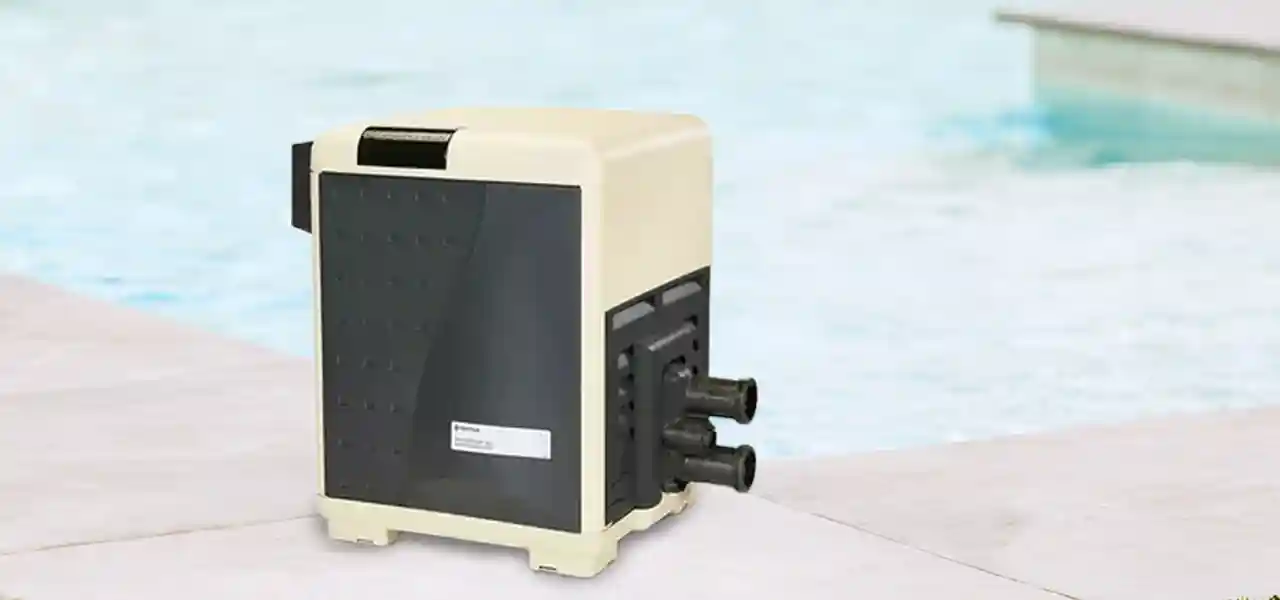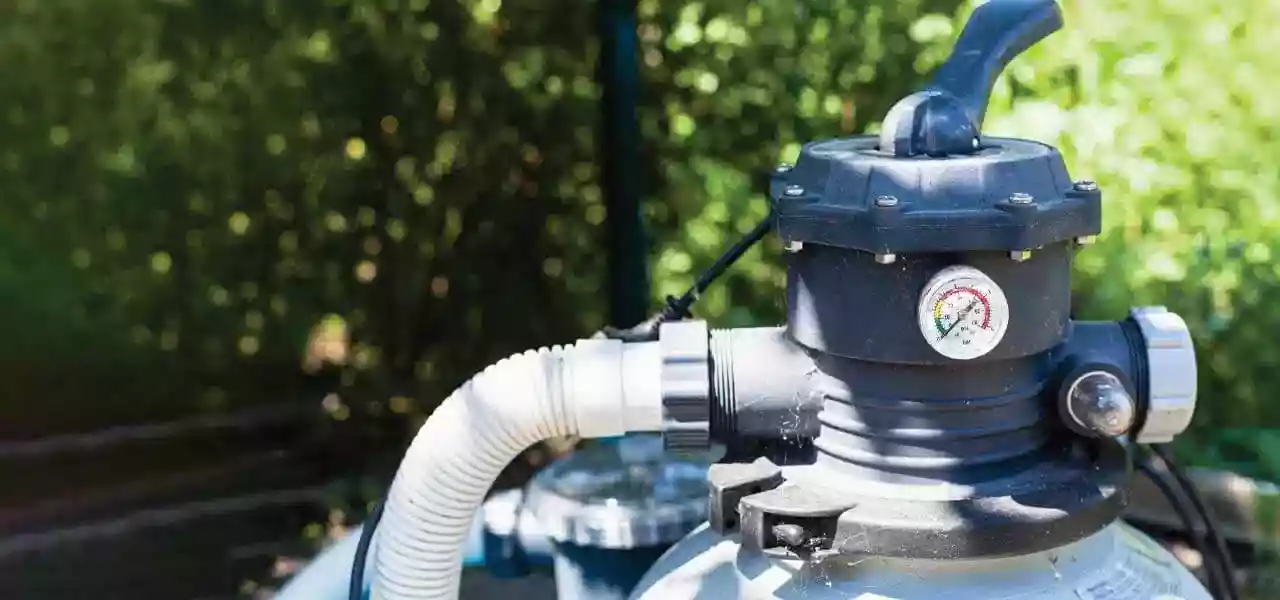What do you do when the heater will not fire-off, leaving you with a cold swimming pool? Today we cover the most common reasons why a pool heater will not start up in this pool heater repair article.
The most common issue when a swimming pool heater won’t heat is also the simplest one, a dirty swimming pool filter. They say that up to 70% of all ‘My heater won’t heat’ service calls are due to low water flow. The heater has a pressure switch and an internal bypass, to ensure the correct amount of incoming water flow, before it will turn on. A dirty pool filter or pump basket will restrict the water flow, so always ensure that everything is clean and all valves are open. Check that your filter pressure gauge is normal, that’s a good indicator and proxy for flow rates.
Natural Gas vs. Propane Heater Pool Heater Repair
There are two types of gas pool heaters, natural gas and propane. For more advanced trouble shooting on a pool heater, you will need a power meter or multi-meter to check the current as it flows through the various heater components. ”The problem lies where the power dies…” All swimming pool heaters have what we refer to as the control loop. This is a simple circuit (think school science fair, with a battery, switch, and light) that goes through a number of safety controls, or checks before the heater is allowed to fire-off. Only if all the safety switches are enabled will the heater turn on, and begin to heat the water. As stated above, the most common pool heater repair issue is water flow, but let’s start from the beginning.
Power Source

All heater control circuits run on electricity. Your heater will have one of two power sources, line voltage from a breaker box, timeclock or outlet, or milli-voltage that your heater makes on its own. If you have a standing, always-on pilot light that is manually lit, you have a millivolt pool heater. The heat from the pilot flame heats two dissimilar metals in a bulb (thermocouple or pilot generator) next to the pilot to produce the milli-voltage (less than 1 volt) to power the gas valve and control circuit. The pilot generator must be positioned properly, immersed in the pilot flame, to heat up sufficiently to create the small amount of voltage.
These days, millivolt pool heaters have lost ground to electronic pool heaters. Electronic pool heaters are supplied with power that runs through a transformer as it enters the heater. The reduced voltage, usually 24 volts, is then sent into a control module, aka IID or Fenwal. This gray box sends power to the control circuit. Once you have established you are getting power through the transformer (24 volts) or from the Pilot Generator, aka thermopile, (400-600 mv), then we “follow” the power with our multi-meter, looking for a Voltage Drop at any one of the components in the heater.
Safety Switches
You will need to follow the power to each safety switch. The first one is the pressure switch. This switch makes sure enough water is flowing through the unit before it will let the pool heater turn on. This means you must have the pump on and a clean filter for this switch to close and allow voltage to pass through. With a multi-meter, you should get voltage reading through the pressure switch if it’s working right. You can also jump-out the pressure switch, by using a bent wire or needle nose pliers to touch both contacts at the same time, allowing the current to flow around or bypass the switch. This should be done only for testing purposes, do not operate your heater with the pressure switch bypassed.
Bypass Valves
A word on bypass valves. Most pool heaters have an internal bypass valve that is located inside of the front header of the heater (where the pipes go in and out). It’s not actually a ‘valve’ like you have to control your skimmer and main drain, but a spring loaded door that allows excess water pumped into the heater to return, immediately out of the heater, without being heated. This is necessary to keep the optimum flow of water through the heat exchanger. Too much water flow can cause condensation, erosion, and poor performance. If you have a high flow pool pump, you may want to consider installing an external bypass, outside of the heater. This is a plumbing manifold that diverts a percentage of water “around” the heater, bypassing it back to the pool.
High Limit Switches
The next stop for the power is to the high limit switches. Most heaters have two high limits, usually located side-by-side on the outlet manifold, a ‘low’ high limit usually set to 135° and a high-high limit set to 150°. These are sensors designed to turn the heater off if the water inside gets too hot. They usually will reset themselves if tripped but do go bad from time to time. If your high limits go bad, there could be an issue with the bypass valve in the in/out header causing the unit to overheat, from allowing too much water to bypass the heat exchanger.
From the high limits the power then goes to the thermostat. This is what controls the heater and lets the unit know what temperature to heat up to. When testing your heater, turn the thermostat all the way up. You should find voltage going in and out of this if the probe that goes to the in/out header is working properly.
Thermal Fuse
The next safety switch inline is the fusible link, aka thermal fuse. These sense heat near the gas valve. If the flame from the burners comes into the front of the heater (flame roll out), a small wax pellet inside the link melts, breaking the circuit. The fusible link cannot be reset and if yours has failed, the heater may have a blockage of the burners or improper venting / exhaust from the top of the heater. Be sure to check all possible causes for this, as it could indicate a hazardous situation.
Gas Valves
Next the electric goes to the gas valve and, depending on if you have a 24 volt electronic heater or a millivolt heater, the power then goes to an electric ignition box or IID that will light the pilot. Heater gas valves are less reliable than they should be, and can become stuck closed, become gunked up, or can short-out internally. If all of your safety circuits check out OK, but gas does not seem to be released to the burners, it could be a failed gas valve.
Checking the safety circuit is a good place to start, you should get power into and out of every safety switch in order for the heater to come on. On the newer electronic heaters, many have a circuit board that will give you an error code telling you what switch is not working keep the heater from coming on. Check in your owners manual for a list of error codes.
Of course a circuit board could be the cause of your pool heater repair troubles. Despite improvements over the last 20 years, circuitry can still have trouble with moisture and insects, or irregular voltage.



For the past 5 years my Hayward h200 clicks and clicks and clicks when I turn it on but after three cycles it just gives me the IF code. I know that is for ignition failure however I have been able to get it working by pressing on off about three or four times in a row and then it will ignite. I know I shouldn’t be doing this however I really don’t feel like having someone over to charge me a couple of hundred dollars again for something wrong with the pool.
Please tell me that I can avoid this problem as it has gotten progressively worse and this year I can barely get the pool ignited.
Thanks
HI Vince, you could pull out the igniter, and check the cable and connections, or just replace the igniter, yourself, and save a few hundred bucks. Probably part HAXIGN1931, or it could be the ‘glow plug’ style, IDXLIGN1930, or IDXLIGN1931 depending on your model. Or it could also be IDXL2IGN1930 – just compare visually, they all look different.
Hi. I’ve got one for you. Max-E-Therm 400, won’t fire. PS LED lit on circuit board. With filter running, PS switch is closed. I have continuity at the switch and at the board. No other lights. Jumped switch, no difference. Manual bypass valve ok. PS LED only goes out when I set temp at or below water temp. Any ideas?? Thx.
Try jumping out the wires that lead to and from the pressure switch, they may have shorts in them